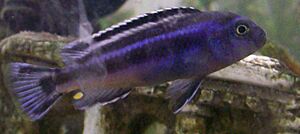Pseudotropheus johannii facts for kids
Quick facts for kids Pseudotropheus johannii |
|
|---|---|
 |
|
| Conservation status | |
| Scientific classification | |
| Synonyms | |
|
Melanochromis johannii (Eccles, 1973) |
The Pseudotropheus johannii is a cool freshwater fish from Africa. It's also known as the bluegray mbuna. This fish belongs to the Cichlidae family, which has many popular aquarium fish.
Contents
Where the Bluegray Mbuna Lives
The bluegray mbuna naturally lives in Lake Malawi in Africa. You can find it along the eastern coast of Mozambique, especially in the shallow areas near the shore. These areas are called littoral zones.
This fish is quite popular with people who keep aquariums. Many fish lovers enjoy having bluegray mbunas in their cichlid tanks. In the aquarium world, it's sometimes called the "electric blue johanni."
What the Pseudotropheus johannii Looks Like
This fish is special because males and females look very different. This is called being sexually dimorphic.
- Females and young fish are bright yellow.
- Males have amazing colors, usually blue or purple mixed with black. They have two blue lines on their bodies. One line goes across their forehead, over their eye, and along their upper body. The second line runs along the lower part of their body.
Why is it Called Pseudotropheus johannii?
The scientific name for this fish, johannii, comes from the German name "Johan." In English, this name is "John." The fish was named to honor a person named John Johns. He was a collector who gathered fish from Lake Malawi for people who wanted to keep them in aquariums.
Keeping Bluegray Mbunas in an Aquarium
If you want to keep a bluegray mbuna, you need to know a few things. These fish are a type of cichlid called "mbuna." They like water that is a bit alkaline, with a pH level between 7 and 9.
They are tropical fish, so they need warm water. The temperature should be between 22 and 28 degrees Celsius (72 to 82 degrees Fahrenheit). The water should also be moderately hard.
Bluegray mbunas can be quite aggressive. Because of this, they are usually kept only with other strong African cichlids. It's best to have one male with two or more females in the same tank. You should not keep more than one male in a tank unless it is very large and has many places for them to hide.
See also
- List of freshwater aquarium fish species


